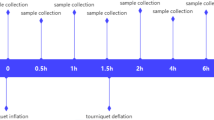Summary
The penetration characteristics of cefazolin and cephradine in human bone were determined in 35 patients undergoing total knee replacement. The results were compared to previously reported data on patients undergoing total hip replacement. The time required to achieve peak bone levels in total knee replacement was less than in total hip replacement. Importantly, peak bone levels in total knee replacement (cefazolin: 11 mg/kg; cephradine: 7 mg/kg) were significantly less (≤50%) than bone levels in total hip replacement (cefazolin: 30 mg/kg; cephradine: 23 mg/kg). The bone half-lives (t1/2) of cephalosporins were prolonged in total knee replacement compared to total hip replacement because of the tourniquet effect. The reduction in peak bone levels and the bone t1/2 of cephalosporins should be taken into account in patients receiving prophylaxis for total knee replacement. Therefore, patients undergoing total knee replacement should receive 2 g of a parenteral cephalosporin 30 min prior to surgery in order to achieve the same degree of protection, i. e., peak bone levels, as is achieved with 1 g of a cephalosporin administered prophylactically to patients undergoing total hip replacement. If the critical effect of the tourniquet is not taken into account in antibiotic prophylaxis for patients undergoing total knee replacement, then suboptimal bone cephalosporin levels may result.
Zusammenfassung
Das Penetrationsverhalten von Cefazolin und Cephradin in menschlichen Knochen wurde bei 35 Patienten untersucht, bei denen ein totaler Kniegelenksersatz durchgeführt wurde. Die Ergebnisse wurden mit publizierten Daten bei Patienten mit totalem Hüftgelenksersatz verglichen. Die Maximalspiegel wurden bei totalem Kniegelenksersatz früher erreicht als bei Hüftgelenksersatz, sie lagen — was von Bedeutung ist — bei totalem Kniegelenksersatz um ≤ 50% signifikant niedriger (Cefazolin 11 mg/kg, Cephradin 7 mg/kg) als bei totalem Hüftgelenksersatz (Cefazolin 30 mg/kg, Cephradin 23 mg/kg). Die Halbwertszeit (t1/2) der Cephalosporine im Knochen war aufgrund des Tourniquet-Effekts bei totalem Kniegelenksersatz länger als bei Hüftgelenksersatz. Die niedrigeren Knochenspitzenspiegel und veränderten Halbwertszeiten von Cephalosporinen sollten bei der Antibiotikaprophylaxe bei totalem Kniegelenksersatz berücksichtigt werden. Daher sollten Patienten 30 min vor diesem chirurgischen Eingriff 2 g eines parenteralen Cephalosporins erhalten, um einen Antibiotikaschutz, d. h. Knochenspitzenspiegel zu erreichen, die den bei komplettem Hüftgelenksersatz mit 1 g Cephalosporin erzielten Spitzenspiegeln entsprechen. Wenn dieser wichtige Tourniquet-Effekt nicht berücksichtigt wird, besteht die Möglichkeit, daß bei totalem Kniegelenksersatz Antibiotikaprophylaxe mit suboptimalen Cephalosporin-Knochenspiegeln betrieben wird.
Similar content being viewed by others
Literature
Coventry, M. B. Treatment of infections occurring in total hip surgery. Orthop. Clin. North Am. 6 (1975) 991–1003.
Fitzgerald, R. H., Jr., Nolan, D. R., Ilstrup, D. M., Van Scoy, R. E., Washington, J. A. II, Coventry, M. B. Deep wound sepsis following total hip arthroplasty. J. Bone Joint Surg. [Am] 59 (1977) 847–855.
Nelson, J. P. Deep infection following total hip arthroplasty. J. Bone Joint Surg. [Am] 59 (1977) 1042–1044.
Petty, W., Bryan, R. S., Coventry, M. B., Peterson, L. F. A. Infection after total knee arthroplasty. Orthop. Clin. North Am. 6 (1975) 1005–1014.
Pavel, A., Smith, R. L., Ballard, A., Larson, I. J. Prophylactic antibiotics in elective orthopedic surgery: A prospective study of 1,591 cases. South. Med. J. 70 (1977) 50–55.
Kegel-Szerejko, M., Maderazo, E. G., Cunha, B. A., Scull, E., Gossling, H. R. Host factors and prosthetic joint infections. Am. J. Infect. Control 9 (1981) 43–49.
Cunha, B. A., Quintiliani, R., Nightingale, C. H. Antimicrobial prophylaxis in orthopedic and cardiovascular surgery. Clin. Ther. 2 (1979) 211–223.
Barza, M., Butler, T. The penetration of penicillins and cephalosporins into selected sites of clinical interest. In:Weinstein, L., Fields, B. S. (eds.): Seminars in Infectious Disease, vol. 3. Thieme-Stratton, Inc., New York 1980, pp. 193–224.
Burke, J. F. Preventing bacterial infection by coordinating antibiotic and host activity: A time-dependent relationship. South. Med. J. 70 (1977) 24–26.
Cunha, B. A., Gossling, H. R., Pasternak, H. S., Nightingale, C. H., Quintiliani, R. The penetration characteristics of cefazolin, cephalothin, and cephradine into bone in patients undergoing total hip replacement. J. Bone Joint Surg. [Am] 59 (1977) 856–859.
Lilly. Product Information. Kefzol (Cefazolin). A review of clinical and laboratory studies and a bibliography of the medical literature. Lilly Laboratories, Indianapolis 1975.
Squibb. Product Information. Velosef (Cephradine). E. R. Squibb and Sons, Inc., Princeton 1975.
Schurman, D. J., Hirshman, H. P., Nagel, D. A. Antibiotic penetration in infected and normal knee joints. Clin. Orthop. 136 (1978) 304–310.
Author information
Authors and Affiliations
Rights and permissions
About this article
Cite this article
Cunha, B.A., Gossling, H.R., Pasternak, H.S. et al. Penetration of cephalosporins into bone. Infection 12, 80–84 (1984). https://doi.org/10.1007/BF01641676
Received:
Accepted:
Issue Date:
DOI: https://doi.org/10.1007/BF01641676




